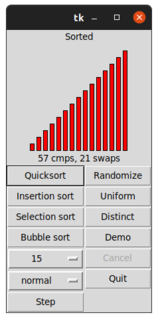
In computing, multitasking is the concurrent execution of multiple tasks over a certain period of time. New tasks can interrupt already started ones before they finish, instead of waiting for them to end. As a result, a computer executes segments of multiple tasks in an interleaved manner, while the tasks share common processing resources such as central processing units (CPUs) and main memory. Multitasking automatically interrupts the running program, saving its state and loading the saved state of another program and transferring control to it. This "context switch" may be initiated at fixed time intervals, or the running program may be coded to signal to the supervisory software when it can be interrupted.
A real-time operating system (RTOS) is an operating system (OS) for real-time applications that processes data and events that have critically defined time constraints. A RTOS is distinct from a time-sharing operating system, such as Unix, which manages the sharing of system resources with a scheduler, data buffers, or fixed task prioritization in a multitasking or multiprogramming environment. Processing time requirements need to be fully understood and bound rather than just kept as a minimum. All processing must occur within the defined constraints. Real-time operating systems are event-driven and preemptive, meaning the OS is capable of monitoring the relevant priority of competing tasks, and make changes to the task priority. Event-driven systems switch between tasks based on their priorities, while time-sharing systems switch the task based on clock interrupts.

In computer science, a sorting algorithm is an algorithm that puts elements of a list into an order. The most frequently used orders are numerical order and lexicographical order, and either ascending or descending. Efficient sorting is important for optimizing the efficiency of other algorithms that require input data to be in sorted lists. Sorting is also often useful for canonicalizing data and for producing human-readable output.

In computing, virtual memory, or virtual storage is a memory management technique that provides an "idealized abstraction of the storage resources that are actually available on a given machine" which "creates the illusion to users of a very large (main) memory".

In computing, a process is the instance of a computer program that is being executed by one or many threads. It contains the program code and its activity. Depending on the operating system (OS), a process may be made up of multiple threads of execution that execute instructions concurrently.

The Commodore PET is a line of personal computers produced starting in 1977 by Commodore International. A single all-in-one case combines a MOS Technology 6502 microprocessor, Commodore BASIC in read-only memory, keyboard, computer monitor, and, in early models, a cassette deck.
In computer science, algorithmic efficiency is a property of an algorithm which relates to the amount of computational resources used by the algorithm. An algorithm must be analyzed to determine its resource usage, and the efficiency of an algorithm can be measured based on the usage of different resources. Algorithmic efficiency can be thought of as analogous to engineering productivity for a repeating or continuous process.
In computer science, program optimization, code optimization, or software optimization, is the process of modifying a software system to make some aspect of it work more efficiently or use fewer resources. In general, a computer program may be optimized so that it executes more rapidly, or to make it capable of operating with less memory storage or other resources, or draw less power.
In computer operating systems, memory paging is a memory management scheme by which a computer stores and retrieves data from secondary storage for use in main memory. In this scheme, the operating system retrieves data from secondary storage in same-size blocks called pages. Paging is an important part of virtual memory implementations in modern operating systems, using secondary storage to let programs exceed the size of available physical memory.

In the maintenance of file systems, defragmentation is a process that reduces the degree of fragmentation. It does this by physically organizing the contents of the mass storage device used to store files into the smallest number of contiguous regions. It also attempts to create larger regions of free space using compaction to impede the return of fragmentation. Some defragmentation utilities try to keep smaller files within a single directory together, as they are often accessed in sequence.
In computer science, thrashing occurs when a computer's virtual memory resources are overused, leading to a constant state of paging and page faults, inhibiting most application-level processing. This causes the performance of the computer to degrade or collapse. The situation can continue indefinitely until either the user closes some running applications or the active processes free up additional virtual memory resources.
In computing, a page fault is an exception that the memory management unit (MMU) raises when a process accesses a memory page without proper preparations. Accessing the page requires a mapping to be added to the process's virtual address space. Besides, the actual page contents may need to be loaded from a backing store, such as a disk. The MMU detects the page fault, but the operating system's kernel handles the exception by making the required page accessible in the physical memory or denying an illegal memory access.
Descriptors are an architectural feature of Burroughs large systems, including the current Unisys Clearpath/MCP systems. Apart from being stack- and tag-based, a notable architectural feature of these systems is that it is descriptor-based. Descriptors are the means of having data that does not reside on the stack as for arrays and objects. Descriptors are also used for string data as in compilers and commercial applications.
WHDLoad is a software package for the Amiga platform to make installation of software to a hard disk easier, for such things as demos or games. Allowing for better compatibility for Amiga software, which can sometimes have hardware incompatibilities making them hard to use in emulated environments due to the widely varying hardware specifications of the Amiga product line across its history. WHDLoad basically circumvents the operating system in the Amiga for greater compatibility and preserves the original program environment.
In computing, a system resource, or simply resource, is any physical or virtual component of limited availability within a computer system. All connected devices and internal system components are resources. Virtual system resources include files, network connections, and memory areas.
Working set is a concept in computer science which defines the amount of memory that a process requires in a given time interval.
Scratch space is space on the hard disk drive that is dedicated for storage of temporary user data. It is unreliable by intention and has no back up. Scratch disks may occasionally be set to erase all data at regular intervals so that the disk space is left free for future use. The management of scratch disk space is typically dynamic, occurring when needed. Its advantage is that it is faster than e.g. network filesystems.
In computer storage, fragmentation is a phenomenon in which storage space, main storage or secondary storage, is used inefficiently, reducing capacity or performance and often both. The exact consequences of fragmentation depend on the specific system of storage allocation in use and the particular form of fragmentation. In many cases, fragmentation leads to storage space being "wasted", and in that case the term also refers to the wasted space itself.

A computer is a digital electronic machine that can be programmed to carry out sequences of arithmetic or logical operations (computation) automatically. Modern computers can perform generic sets of operations known as programs. These programs enable computers to perform a wide range of tasks. A computer system is a "complete" computer that includes the hardware, operating system, and peripheral equipment needed and used for "full" operation. This term may also refer to a group of computers that are linked and function together, such as a computer network or computer cluster.

Apache Ignite is a distributed database management system for high-performance computing.







